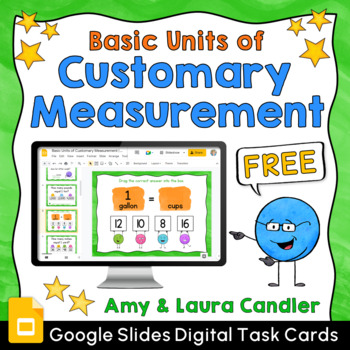- PDF
- Google Apps™
- Internet Activities

Also included in
- The Customary Measurement Conversions Google Slides Bundle includes three slide decks of digital task cards that can be used to review and practice the skill of converting between customary units of measurement. These interactive Google Slides include include a mix of problems for length, weight, anPrice $4.50Original Price $6.00Save $1.50
- The Customary Measurement Conversions Boom Cards and Google Slides Bundle includes three decks of digital task cards in two different formats that can be used to review and practice the skill of converting between customary units of measurement. These interactive digital task cards include include aPrice $6.00Original Price $12.00Save $6.00
Description
Basic Units of Customary Measurement Google Slides includes 16 interactive digital task cards for reviewing the basic units of customary measurement for length, weight, and liquid volume, or capacity. Two versions of this slide deck are included in the product. One version has answers below the task cards that students can uncover to check their work, and the other version does not have answers. Printable and digital answer keys are also provided.
Customary Measurement Conversions Google Slides
This free deck of Google Slides was created as a way to check students' mastery of the basic units of customary measurement. The problems on these slides do not require students to convert between different units of measurement. If your students need practice converting measurement units, check out the two slide decks below:
Please be aware that these Google Slides are NOT self-grading, although two types of answer keys are provided. These digital task cards were designed to foster active engagement during whole group instruction, in small guided math groups, and when used for cooperative learning lessons.
Also Available in Self-Grading Boom Cards Format
If you prefer self-grading interactive task cards that include read-aloud directions, check out my Basic Units of Customary Measurement Boom Cards. These digital task cards are similar to these Google Slides, but in addition to being self-grading, they have a sound icon that students can click to hear the words on the task cards read aloud.
⭐More Google Slides Task Cards from Amy and Laura Candler⭐
- Greek and Latin Root Words Google Slides Bundle
- Plural and Possessive Nouns Google Slides Bundle
- Penguin Fractions Google Slides Bundle
- Classifying Polygons Google Slides Bundle
- Order of Operations Google Slides Bundle
- Place Value Google Slides Bundle
- Comparing Decimals Google Slides Bundle
- States and Capitals Google Slides Bundle
- Monster Math Facts Google Slides Bundle






